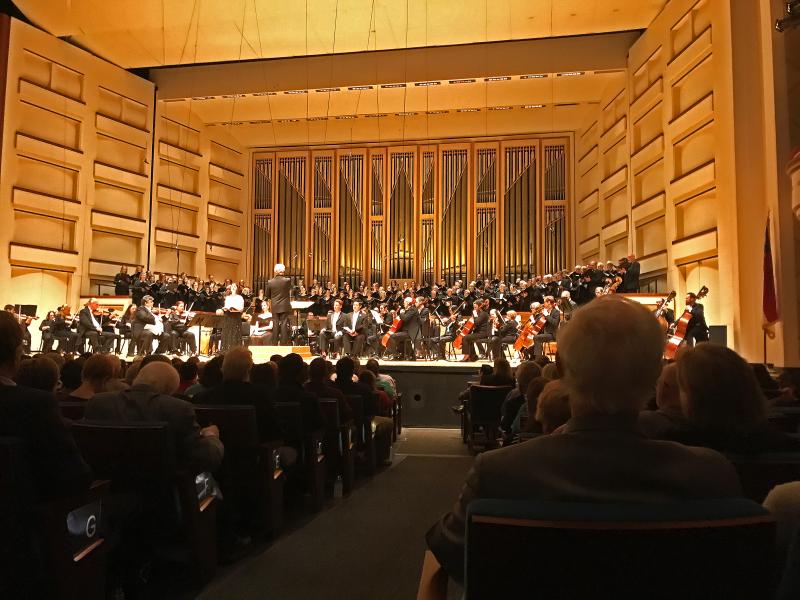Review: MOZART REQUIEM Clashes With Sunny Salieri Symphony
 It's been 40 years since Peter Shaffer's Amadeus vilified, ridiculed, defamed, and demonized Mozart's less-gifted contemporary, Antonio Salieri, presenting the prolific composer and conductor as Wolfgang's fiendish murderer. Shaffer wasn't the first to riff on this unfounded smear, for the great Russian poet Alexander Pushkin peddled it in Mozart and Salieri, his 1830 verse play.
It's been 40 years since Peter Shaffer's Amadeus vilified, ridiculed, defamed, and demonized Mozart's less-gifted contemporary, Antonio Salieri, presenting the prolific composer and conductor as Wolfgang's fiendish murderer. Shaffer wasn't the first to riff on this unfounded smear, for the great Russian poet Alexander Pushkin peddled it in Mozart and Salieri, his 1830 verse play.
Although he omitted his villain's name from his title, Shaffer has proven equally bountiful to both composers, humanizing Mozart and bringing fresh life to Salieri's name. Ian McKellan won a Tony Award as Salieri in the 1980 Broadway production and F. Murray Abraham repeated the triumph in the 1984 Miloš Forman film, winning the Oscar over Tom Hulce, who was a runner-up playing the title role.
So it's altogether fitting that Salieri's 1775 Symphony in D "Il giorno onamstico," likely marking the Italian's Belk Theater and Charlotte Symphony debuts, should be in the shadow of Mozart's Requiem. During the composition of this work, which remained unfinished at his death, it was Mozart who first voiced the suspicion that he was being poisoned and that his mysteriously commissioned Requiem was diabolically planned for his own funeral.
Mozart later scoffed at his own poisoning paranoia, and the Requiem wasn't premiered until late 1793, two years after his death, completed by his student, Franz Xaver Süssmyer. But the baseless murder accusation affixed itself to Salieri. And why not take advantage of Shaffer's preposterous mythologizing if it draws more people to the music? Symphony was only too glad to borrow the indelible Amadeus poster art for this concert's prepublicity. "Poor Salieri!" said Charlotte Symphony music director Christopher Warren-Green, upon picking up a hand mic to introduce Antonio's piece.
That was after a reprise of Nkeiru Okoye's "Charlotte Mecklenburg," which received its world premiere last September, kicking off the current season. The encore was triply justified: the piece was originally performed one night only at a special opening night gala and not part of the season's subscription, we're still celebrating the 250th anniversary of the city's incorporation, and the piece - commissioned by Symphony - is non-threatening to traditionalists and worth a second hearing.
It was easier for me to ascertain on my second go-round that the opening theme, very much in the Aaron Copland manner of evoking Appalachia and the American heartland, was something that Okoye would circle back to near the end of her historical portrait. What came in between statements of her "Queen City Hymn" was more daring and original. There was urban bustle and cacophony mixed with a mountain lilt, snatches of a Scottish fiddle tune and a post-Civil War protest song, and an unexpected glance southward.
A brief marimba concerto popped up, then a muted trumpet and a cool samba beat. Okoye's objective of portraying the city's multiethnicity was more successfully reached than her objective of depicting our racial tensions. The codetta, beautifully played by harpist Andrea Mumm Trammell, expressed hopes for the future residing in the innocence of our children. Or that was Okoye's stated intent. For an affirmation, it was notably faint.
Not at all saturnine like Salieri's stage and screen image, his Symphony in D was sunny and cheerful from the outset, the opening Allegro launched with a lively flourish of horns and winds. Both of the middle movements offered opportunities for principal bassoonist Olivia Oh. The charming Larghetto remained summery in spite of its weepy violins, and the Minuet alternated attractively between mellow and anthemic themes. Warren-Green vigorously pushed the pace of the closing Allegretto, lightly carried forward by the strings when the winds weren't adding body and zest.
When the entire orchestra joined together toward the end of "The Name Day," the music briefly grew joyous and grand. It was almost as if Salieri was apologizing for this outburst when the strings alone crept around stealthily in staccato phrases, but the whole orchestra came back for a crisp, good-humored finish.
Warren-Green's programming effectively flipped the Hulce-Abraham characters we remember from Hollywood's Amadeus, assigning all the frivolity to Salieri, but he didn't mess with the awesome impression of Mozart's Requiem that lingers after we have seen the film. Unlike some of the Mozart performances we've seen before from Warren-Green and his predecessor, Christof Perick, a robust assembly of musicians, guest soloists, and the Charlotte Symphony Chorus filled the Belk stage.

If the occasionally fierce reading that emerged from this formidable congress didn't totally accord with Mozart's accepting intentions, there was no doubting its power. The "Dies irae" rang out impressively, taut with terror, and the "Tuba mirum" was a fine spotlight for all four guest vocalists, particularly bass Adam Lau, smoothly accompanied by principal trombonist John Bartlett before giving way to tenor Isaiah Bell. Having already distinguished herself in the soprano section of the opening "Requiem aeternum" segment with the Chorus, Margot Rood floated in gracefully over mezzo Sofia Selowsky toward the end of the "Tuba."
Overshadowed here somewhat, Selowsky had better opportunities further along in the mass, leading off the "Recordare" and "Benedictus" sections when all the solo vocalists stood up again. Still it was Rood who shone brightest, drawing the opening moments of the concluding "Lux aeterna" and sprinkling her loveliness all over before the music grew grander and fugal with the full ensemble joining in.
The orchestra made its presence known most emphatically when the brass and timpani underscored the most dramatic choral moments. Aside from the whiplash "Dies irae," there was ringing majesty at the start of the "Rex tremendae" that contrasted affectingly with the hushed women when we reached the "salve me" pleas. Symphony Chorus showed more finesse in the "Lacrimosa," beginning softly over the orchestra's keening strings, with some satisfying crescendos preceding the satisfying "Amen."
Warren-Green and chorus director Kenney Potter may have been thinking more of Buckingham Palace than a church when they prepared Symphony Chorus for the climactic "Sanctus." Both the orchestra and the choir suffused the repeated holies with a pomp and fervor of "God Save the Queen" proportions. Or maybe they had Westminster Abbey in mind. Warren-Green has played that joint as well.
Videos
